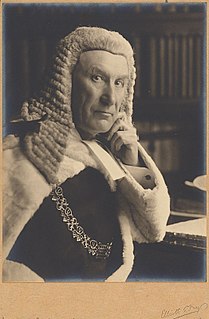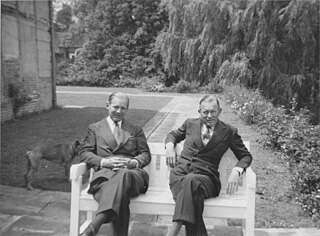Baron Cromwell is a title that has been created several times in the Peerage of England. The first creation, which was by writ, was for John de Cromwell in 1308. On his death, the barony became extinct. The second creation came in 1375 when Ralph de Cromwell was summoned by writ to Parliament as Lord Cromwell. His grandson, the third baron, served as Lord High Treasurer to King Henry VI. However, on his death in 1455 the barony fell into abeyance between his nieces Maude and Joan. On Joan's death in 1490 the abeyance was terminated in favour of Maude, the fourth holder. When she died childless in 1497 the peerage once again fell into abeyance, this time between the daughters of the first baron. The title remained in abeyance for over 400 years. However, in 1922 the Committee for Privileges of the House of Lords reported in favour of the petition for the termination of the abeyancy of Selina Frances Bewicke-Copley. She was the daughter of Sir Charles Watson Copley, 3rd Baronet, and one of the co-heirs of Maud, daughter of the first baron Cromwell. Selina died in 1923 and in July of the same year the abeyance was terminated in favour of her son Robert Godfrey Wolesley Bewicke-Copley, who became the fifth baron. He notably served as Lord Lieutenant of Leicestershire. As of 2010 the ancient barony is held by his grandson, the seventh baron, who succeeded his father in 1982. Having lost his seat in the House of Lords under the House of Lords Act 1999, in April 2014 he was elected at a hereditary peers' by-election as a Crossbencher.
Baron Marchamley, of Hawkestone in the County of Salop, is a title in the Peerage of the United Kingdom. It was created in 1908 for the Liberal politician George Whiteley, who had previously represented Stockport and Pudsey in the House of Commons. As of 2014 the title is held by his great-grandson, the fourth Baron, who succeeded his father in 1994.

Baron Faringdon, of Buscot Park in the County of Oxfordshire, is a title in the Peerage of the United Kingdom. It was created in 1916 for Sir Alexander Henderson, 1st Baronet, who had previously represented Stafford West and St George's, Hanover Square in the House of Commons as a Liberal Unionist. He had already been created a baronet in 1902. He was succeeded by his grandson, the second Baron. He was the son of the Hon. Harold Henderson, eldest son of the first Baron, who predeceased his father. Lord Faringdon was a member of the London County Council. As of 2017 the titles are held by his nephew, the third Baron, who succeeded in 1977. He is the son of the Hon. Michael Thomas Handerson, second son of the Hon. Harold Henderson.

Baron Harmsworth, of Egham in the County of Surrey, is a title in the Peerage of the United Kingdom. It was created in 1939 for the Liberal politician Cecil Harmsworth, Under-Secretary of State for Foreign Affairs between 1919 and 1922. As of 2017 the title is held by his grandson, the third Baron, who succeeded his uncle in 1990.
Baron Gainford, of Headlam in the County Palatine of Durham, is a title in the Peerage of the United Kingdom. It was created on 3 January 1917 for the Liberal politician Jack Pease, a member of the Darlington Pease family. He notably served as President of the Board of Education from 1911 to 1915. Pease was the second son of Sir Joseph Pease, 1st Baronet, and the grandson of Joseph Pease, while Arthur Pease was his uncle and Sir Arthur Pease, 1st Baronet, Beaumont Pease, 1st Baron Wardington, and Herbert Pease, 1st Baron Daryngton, were his first cousins. The third baron was a former member of the London County Council and of the Greater London Council. As of 2013 the title is held by his younger brother, the fourth baron, an architect and town planner; County Planning Officer for Ross and Cromarty 1967–1975 and Scottish Office Inquiry Reporter 1978–1993.
Baron Glendyne, of Sanquhar in the County of Dumfries, is a title in the Peerage of the United Kingdom. It was created on 23 January 1922 for the businessman Sir Robert Nivison, 1st Baronet. He was a senior partner in the firm of R. Nivison and Co, stockbrokers. Nivison had already been created a Baronet on 21 July 1914. As of 2010 the titles are held by his great-grandson, the fourth Baron, who succeeded his father in 2008.

Baron Darling, of Langham in the County of Essex, is a title in the Peerage of the United Kingdom. It was created on 12 January 1924 for Sir Charles Darling, a former Conservative Member of Parliament for Deptford and Judge of the High Court of Justice. As of 2017 the title is held by his great-grandson, the third Baron, who succeeded his father in 2003.

Baron Shaughnessy, of the City of Montreal in the Dominion of Canada and of Ashford in the County of Limerick, is a title in the Peerage of the United Kingdom. It was created in 1916 for the Milwaukee born businessman Thomas Shaughnessy, president of the Canadian Pacific Railway Company. He was succeeded by his eldest son, the second Baron, a Director of the CPR and of the Canadian Bank of Commerce. His son, the third Baron, was a businessman and was also active in the House of Lords. However, he lost his hereditary seat in parliament after the House of Lords Act 1999.
Baron Maclay, of Glasgow in the County of Lanark, is a title in the Peerage of the United Kingdom. It was created in 1922 for the Scottish businessman Sir Joseph Maclay, 1st Baronet. He was Chairman of Maclay & Macintyre, shipowners, of Glasgow, and also served as Minister of Shipping in the war-time coalition of David Lloyd George, without being in Parliament. Maclay had already been created a Baronet, of Park Terrace in the City of Glasgow in the County of Lanark, in 1914. His eldest surviving son, the second Baron, represented Paisley in the House of Commons as a Liberal. As of 2010 the titles are held by the latter's eldest son, the third Baron, who succeeded in 1969.
Baron Moran, of Manton in the County of Wiltshire, is a title in the peerage of the United Kingdom. It was created on 8 March 1943 for the physician Charles Wilson. He is chiefly remembered as Winston Churchill's personal physician during the Second World War and was president of the Royal College of Physicians from 1941 to 1949. His diary of his association with Churchill—that continued to Winston's death in 1965—was published in 1966.

Baron Borwick, of Hawkshead in the County of Lancaster, is a title in the Peerage of the United Kingdom. It was created on 20 July 1922 for the businessman Sir Robert Borwick, 1st Baronet. He was chairman of George Borwick & Sons Ltd, manufacturers of baking and custard powders. The company had been founded by his father George Borwick. Before his elevation to the peerage, Borwick had been created a baronet, of Eden Lacy in the Parish of Lazonby in the County of Cumberland, on 1 July 1916. His eldest son, the second Baron, was succeeded by his younger brother, the third Baron. The latter was succeeded by his son, the fourth Baron. As of 2014 the titles are held by his nephew, the fifth Baron, who succeeded in 2007. Lord Borwick is the eldest son of the Hon. Robin Borwick, third son of the third Baron. The family tomb is maintained at the Cimetières du Château in Nice.

Baron Brassey of Apethorpe, of Apethorpe in the County of Northampton, is a title in the Peerage of the United Kingdom. It was created in 1938 for Sir Henry Brassey, 1st Baronet, who had previously represented Northamptonshire Northern and Peterborough in the House of Commons as a Conservative. He had already been created a Baronet, of Apethorpe in the County of Northampton, in 1922. Brassey was the second but eldest surviving son of Henry Brassey, third son of Thomas Brassey, and the nephew of Thomas Brassey, 1st Earl Brassey, and Albert Brassey. as of 2022 the titles are held by his great-grandson, the fourth Baron, who succeeded his father in 2015.

Baron Trevethin, of Blaengawney in the County of Monmouth, is a title in the Peerage of the United Kingdom. It was created in 1921 for the prominent judge Sir Alfred Lawrence, Lord Chief Justice of England from 1921 to 1922.
Baron Darwen, of Heys-in-Bowland in the West Riding of the County of York, is a title in the Peerage of the United Kingdom. It was created on 12 February 1946 for John Davies, a prominent cotton manufacturer. He served as a Lord-in-waiting from 1949 to 1950 in the Labour administration of Clement Attlee. As of 2011 the title is held by his great-grandson, the fourth Baron, who succeeded his father in 2011.
Baron Layton, of Danehill in the County of Sussex, is a title in the Peerage of the United Kingdom. It was created in 1947 for Sir Walter Layton, a prominent economist, editor and newspaper proprietor. He was editor of The Economist from 1922 to 1938. As of 2019 the title is held by his grandson, the fourth Baron—son of the first Baron's younger son David Layton—who succeeded in 2018.

Joseph Watson, 1st Baron Manton was an English industrialist from Leeds, Yorkshire.

Houghton Hall, Sancton, near Market Weighton, is a Grade I listed Georgian country mansion in the East Riding of Yorkshire, England, set in an estate of 7,800 acres (32 km2). Located on the estate is the village of Sancton and the vestigial remains of the ancient hamlet of Houghton. It was built c. 1765–8 by Philip Langdale to the designs of Thomas Atkinson and underwent minor remodelling in 1960 by Francis Johnson. It is built in pink brick with stone dressing and slate roof, with a three-storey, 5-bay main block.

Miles Watson, 2nd Baron Manton (1899–1968),, of Compton Verney, Warwickshire and Plumpton Place, East Sussex, was an English peer and racehorse breeder.

(Joseph) Rupert Eric Robert Watson, 3rd Baron Manton, DL, of Houghton Hall in the parish of Sancton, Yorkshire, was a British soldier, landowner and racehorse owner who served as Senior Steward of the Jockey Club (1982-5).










